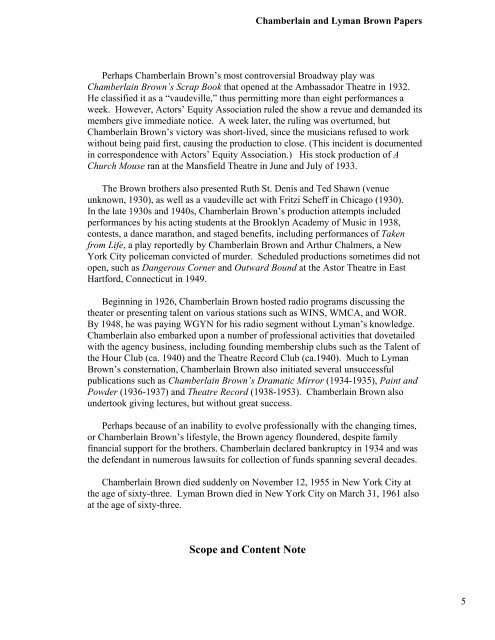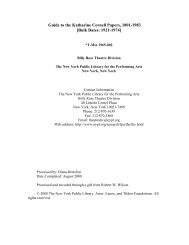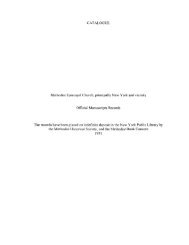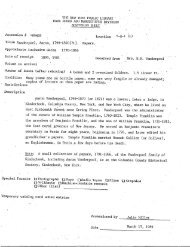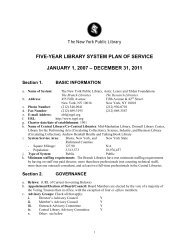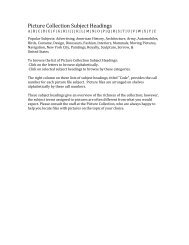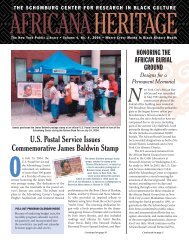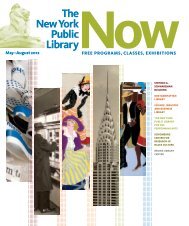View PDF finding aid (590.79 KB) - New York Public Library
View PDF finding aid (590.79 KB) - New York Public Library
View PDF finding aid (590.79 KB) - New York Public Library
You also want an ePaper? Increase the reach of your titles
YUMPU automatically turns print PDFs into web optimized ePapers that Google loves.
Chamberlain and Lyman Brown Papers<br />
Perhaps Chamberlain Brown’s most controversial Broadway play was<br />
Chamberlain Brown’s Scrap Book that opened at the Ambassador Theatre in 1932.<br />
He classified it as a “vaudeville,” thus permitting more than eight performances a<br />
week. However, Actors’ Equity Association ruled the show a revue and demanded its<br />
members give immediate notice. A week later, the ruling was overturned, but<br />
Chamberlain Brown’s victory was short-lived, since the musicians refused to work<br />
without being p<strong>aid</strong> first, causing the production to close. (This incident is documented<br />
in correspondence with Actors’ Equity Association.) His stock production of A<br />
Church Mouse ran at the Mansfield Theatre in June and July of 1933.<br />
The Brown brothers also presented Ruth St. Denis and Ted Shawn (venue<br />
unknown, 1930), as well as a vaudeville act with Fritzi Scheff in Chicago (1930).<br />
In the late 1930s and 1940s, Chamberlain Brown’s production attempts included<br />
performances by his acting students at the Brooklyn Academy of Music in 1938,<br />
contests, a dance marathon, and staged benefits, including performances of Taken<br />
from Life, a play reportedly by Chamberlain Brown and Arthur Chalmers, a <strong>New</strong><br />
<strong>York</strong> City policeman convicted of murder. Scheduled productions sometimes did not<br />
open, such as Dangerous Corner and Outward Bound at the Astor Theatre in East<br />
Hartford, Connecticut in 1949.<br />
Beginning in 1926, Chamberlain Brown hosted radio programs discussing the<br />
theater or presenting talent on various stations such as WINS, WMCA, and WOR.<br />
By 1948, he was paying WGYN for his radio segment without Lyman’s knowledge.<br />
Chamberlain also embarked upon a number of professional activities that dovetailed<br />
with the agency business, including founding membership clubs such as the Talent of<br />
the Hour Club (ca. 1940) and the Theatre Record Club (ca.1940). Much to Lyman<br />
Brown’s consternation, Chamberlain Brown also initiated several unsuccessful<br />
publications such as Chamberlain Brown’s Dramatic Mirror (1934-1935), Paint and<br />
Powder (1936-1937) and Theatre Record (1938-1953). Chamberlain Brown also<br />
undertook giving lectures, but without great success.<br />
Perhaps because of an inability to evolve professionally with the changing times,<br />
or Chamberlain Brown’s lifestyle, the Brown agency floundered, despite family<br />
financial support for the brothers. Chamberlain declared bankruptcy in 1934 and was<br />
the defendant in numerous lawsuits for collection of funds spanning several decades.<br />
Chamberlain Brown died suddenly on November 12, 1955 in <strong>New</strong> <strong>York</strong> City at<br />
the age of sixty-three. Lyman Brown died in <strong>New</strong> <strong>York</strong> City on March 31, 1961 also<br />
at the age of sixty-three.<br />
Scope and Content Note<br />
5


